_ Ferdinand Mang, member of the Bavarian State Parliament, AfD. Munich, 24 August 2022.
1. Inflation and green inflation
1.1 Definitions
There are numerous definitions for inflation, from economics and from everyday life. Most Germans are probably closest to Norbert Blüm’s definition, former federal minister of labour and social affairs, who said that inflation is “the little man’s pickpocket.”
The European Central Bank (ECB) defines inflation as follows:
“In a market economy, the prices of goods and services are subject to constant change. Some products are becoming more expensive, others cheaper. When the prices of goods and services rise in general, and not just the prices of individual products, this is referred to as inflation. Then you can’t buy as much today with 1 euro as you could yesterday. In other words, inflation causes a currency to depreciate over time.”[1]
Based on this definition, green inflation is exactly the inflation that arises as a result of political interventions and regulations with the aim of “climate protection” or “climate rescue”. In Germany, the recently “abolished” EEG surcharge serves as a good example of a policy driving green inflation.[2]
1.2 Monetary policy background
The monetary policy background that led to the sharply increased inflation in 2021 and 2022 is well known. Unfortunately, monetary policy is not in German hands. Since 2008, the ECB has first been pursuing the low interest rate policy, then later also the zero interest rate policy and negative interest rate policy. Money supply growth increased from 8.65 trillion euros in 2008 to over 15.5 trillion euros in 2021.[3] This money supply growth is offset by declining productivity growth in the euro area (2021).[4] This contributes significantly to inflation.
The ECB’s multi-billion-dollar purchase programs during the corona pandemic are another driver of money supply growth.[5]
1.3 Climate policy background
Climate policy has been aggressively pushed into Western politics by think tanks (such as the Club of Rome) and non-governmental organizations. First criticism of economic growth became popular, then criticism of human action and its incompatibility with “the environment”. Important dates of this development are:
- “The Limits to Growth” written in 1972 by the Club of Rome.
- Brundlandt Report in 1987 (leading to the so-called “Earth Summit” in 1992).
- The decision to stop climate change was made in Kyoto in 1997.
The general claim of climate protection is: climate change is man-made and is accelerated by the emission of greenhouse gases, so these must be reduced.
1.4 Implementation of climate policy in Europe
For 20 years, the EU has been gradually restricting its citizens further. The latest example is the one that was decided – and not prevented by the federal government – the end of the internal combustion engine by 2035. After decades of downsizing specifications for combustion engines, this is now the death knell for this key German industry. At the same time, there is government steering in the direction of electromobility.
But the rest of the industry is also suffering. Due to the (constantly increasing) CO2 pricing in the EU and Germany, the domestic industry experiences a competitive disadvantage compared to other countries, since the products can no longer be offered at competitive prices.
Europe’s climate policy is not only harmful. The regulations do not achieve their goal, because if the “clean” domestic industry is put out of business, the “dirty” global industry becomes more cost competitive: carbon leakage occurs, i.e., CO2 is no longer emitted in the EU and Germany, but all the more and unregulated in the rest of the world. Other countries value prosperity and technical progress more than supposed climate salvation.
1.5 Implementation of climate policy in Germany
For years, Germany has been increasing its environmental protection spending by private individuals, companies and the state, as shown in the chart below.[6]
Chart 1. Expenditure for climate protection in Germany (2010 – 2019, in bln euros)
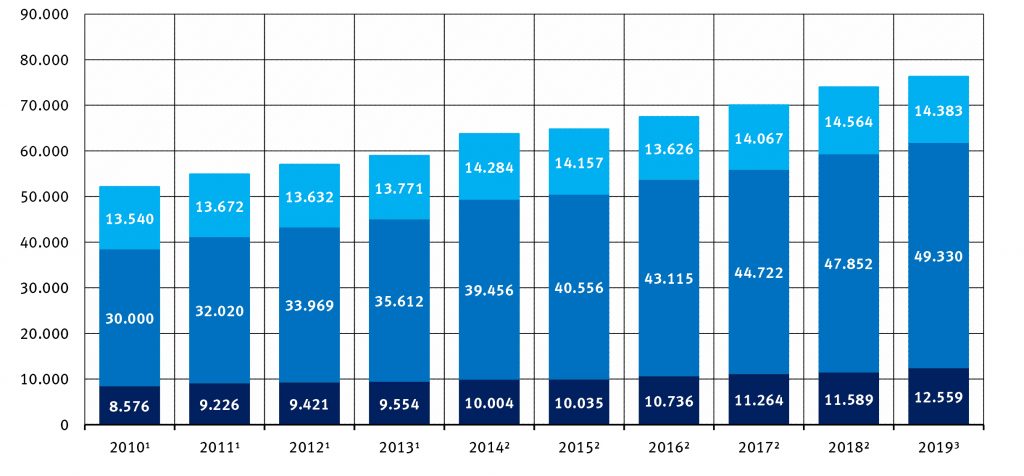
Source: Federal Environment Ministry (2022). | Government expenditure (dark blue), business expenditure (blue), private household expenditure (light blue).
Due to more and more requirements, all economic activities become more expensive, directly and indirectly. A good example in Germany is the national emissions certificate trading, i.e. until 2026 the national carbon levy, regulated by the so-called Greenhouse Gas Emissions Trading Act (TEHG) and the Fuel Emissions Trading Act (BEHG).
Other laws and guidelines enforce “environmentally friendly” measures. In Bavaria, for example, it is not possible to construct a new public building without installing a charging facility for e-cars. In the future, even every public building is to be built using the elaborate timber construction method – the costs don’t matter as long as the climate is “saved”.
Redistribution is achieved through all kinds of taxes or tax benefits (e.g., tax benefits for electric cars) that are intended to supposedly save the climate. Even worse than this redistribution, however, is the debt-financed promotion of electromobility (BAfA grant for the purchase of an electric car, promotion of public charging stations or private wall boxes, etc.), because this creates excess demand. Supply is not growing fast enough in Europe to meet demand.
1.6 Who emits how much carbon dioxide?
Do these environmental policy measures make sense? Can Europe or Germany even reduce a significant proportion of global CO2 emissions through self-restraint? The answer is a plain no. Chart 2 shows the ten largest CO2 emitters.[7]
Chart 2. Largest anthropogenic CO2 emitters (1965 – 2022)
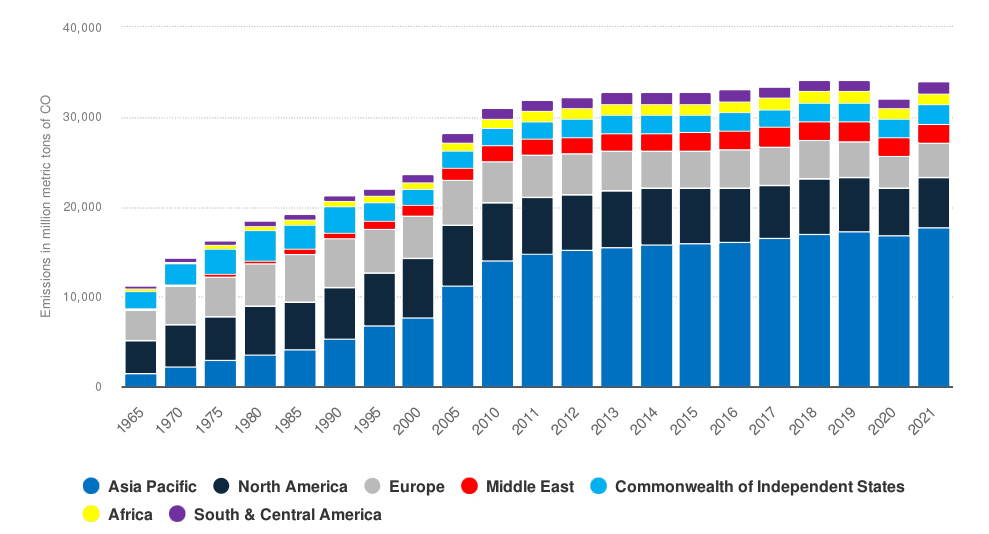
Source: BP (2022).
The order of magnitude quickly becomes evident:
- Germany’s share of total CO2 emissions worldwide is 1.85 percent.
- China emits 30.65 percent.
- The US emits 13.54 percent.
- India emits 7.02 percent.
- The EU-27 together emit less than 14 percent.
1.7 What do we achieve by reducing carbon dioxide emissions?
The reduction of CO2 emissions in the EU would have no real effect but should serve as a “model” for the rest of the world. We go ahead, the rest follows our moral and green way of living and doing business. That’s the idea.
The following facts help to classify: even if Germany or the EU-27 were to halve the current share of CO2 emissions, global emissions would only decrease by 0.93 percent (Germany) or 6.9 percent (EU-27).
Of the around 200 countries that signed the climate agreement in Paris in 2015, only 30 countries (partly non-binding!) committed themselves to reduction targets. China has not agreed to volume targets and “China is still building a new coal-fired power plant every 10 days.”[8]
The USA also withdrew from the climate agreement under president Trump; under president Biden they got back on board, but at the same time begged OPEC to increase oil production.[9]
It goes without saying that no other country seems eager to imitate the European Union’s carbon abatement drive. Because we are forcing a reversal of our standard of living that we built up in the 20th century.
Germany, which would be technologically capable of making masses of energy available at any time of the year, will most likely freeze in the winter of 2022. For ideological reasons, not for technical and economic necessity. The rest of the world looks at the EU and especially at Germany with amazement and dismay.
The climate policy of the EU and Germany, which aims to serve as a “good example” for the rest of the world, achieves its opposite. Nobody but us wants to put themselves in the precarious situation of insecure energy supplies and declining living standards. When the rest of the world sees the Germans gathering around wood stoves again and firewood running out, they just shake their heads.[10]
1.8 Which programs will further fuel green inflation in Germany?
A brief look at which programs will further fuel green inflation without giving us an advantage in terms of security of supply or energy independence.
On the international level:
The new, vague idea of the “climate club” that wants to exclude other non-green countries from a Western climate customs union.[11]
At the German federal level:
“I assume that by 2026 we will earmark around 200 billion euros for climate protection, charging infrastructure, hydrogen technology, the modernization of industry, and the abolition of the EEG surcharge to relieve people”, – announced FDP finance minister Christian Lindner in early 2022.[12]
An additional 60 billion euros for the so-called “Energy and Climate Fund” (EKFG) are approved through credit authorizations approved for the corona pandemic.[13]
In Bavaria:
The Bavarian state government wants to enshrine its climate goals in the Bavarian Climate Protection Act:
- The Bavarian government aims for “climate neutrality” by 2040.
- “Climate neutrality” of the state government by 2023.
- Reduction of greenhouse gas emissions by 65 percent by 2030.
- One billion euros are to be made available for this in 2022 alone and almost 22 billion by 2040.
- Bavaria currently has credit authorizations in the amount of 1.9 billion euros misused, among other things, to deal with the corona pandemic for climate change programs.
1.9 Preliminary conclusion
The green inflation is not a random development, but politically desired. This is also confirmed by Michael Fratzscher, president of the DIW and the “court economist” of the left-wing parties in Germany.[14] According to them, the prices for energy should rise so that:
… the consumption of fossil fuels within Europe is declining.
… the consumer “realizes” that he cannot “pollute the environment” for free.
… the price of energy is so high that new energy innovations become profitable.
… the rest of the world sees that this “climate-friendly” way of doing business is the only way.
The green inflation will lead to the fact that the EU and Germany’s citizens become impoverished, while the rest of the world will gradually move away from “climate protection”.
2. The citizen and green inflation
2.1 Green inflation in everyday life
The inflation rate in Germany rose to near 8 percent in May 2022.[15] Across Europe, we are in the worst phase of inflation since the euro was created. Inflation started as early as the second quarter of 2021. The ECB is now targeting a 25 basis point rate hike in July 2022, while struggling with the widening of EU bond yield spreads as southerners cannot handle even such a small rate hike. This means that alternative solutions will be found. No matter what this alternative solution looks like, it will be at the expense of Germany.
The prices for fossil fuels (e.g., gasoline) were already rising months before the Ukraine conflict. This conflict naturally worsened the situation, but it is not the cause of it. The price of fossil fuels like gasoline was rising months before the Ukraine conflict (see chart).[16]
Chart 3. Average price for Super E10 fuel in Germany (January 2014 to July 2022, in euro cents per litre)
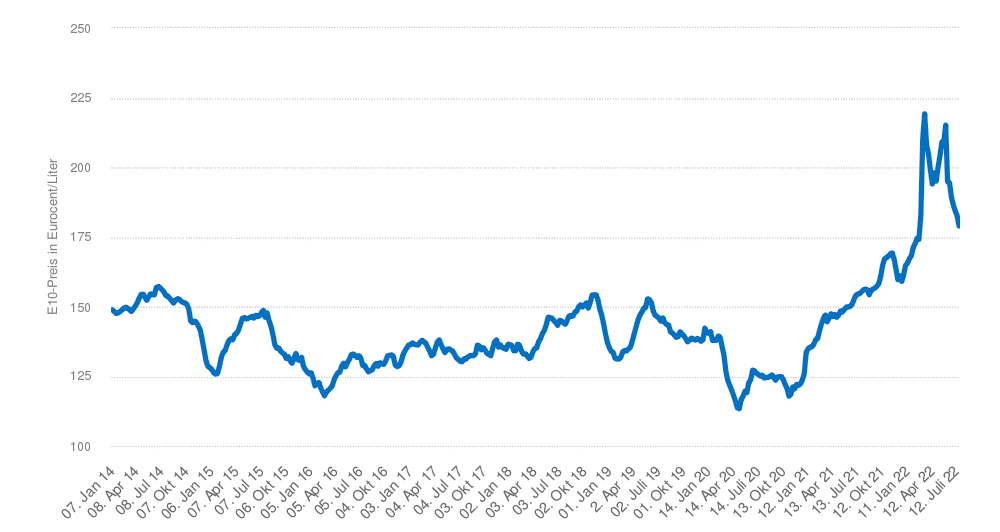
Source: Statista (2022).
2.2 No planning security for companies
In Germany there is no planning security for companies, especially energy-intensive industries are increasingly avoiding Germany. Wacker Chemie prefers to build its plants in Texas, the relocation of the production of combustion engines by BMW and Mercedes was already planned for 2020.[17] The mineral oil companies are also at the mercy of climate politics in Europe and North America. Here, too, green politics leads to green inflation, since companies have no planning security for investments.
You can see that in the development of the petrol price. Often the development of the oil price is compared with the development of the gas price and it is concluded that the gas price must go down if the oil price goes down. However, there are considerable costs involved in processing the oil in motor vehicle fuels.
Due to the corona pandemic and the green saber rattling (the declared “end for fossil fuels”), the refinery capacities in Europe were not expanded. Investments in the future have also been reduced in anticipation of green bans. The corporations, petrol station operators and economists claim that a temporary anti-inflationary federal tax reduction on fuel taxes was passed on. This may be so, however the consumer does not feel it. The ifo Institute attempted a comparison with France and came to the conclusion that the discount was passed on but was not able to absorb the rising prices (see chart).[18]
Chart 4. Diesel prices in Germany and France (04/14/2022 – 06/19/2022, daily average values, in euros)
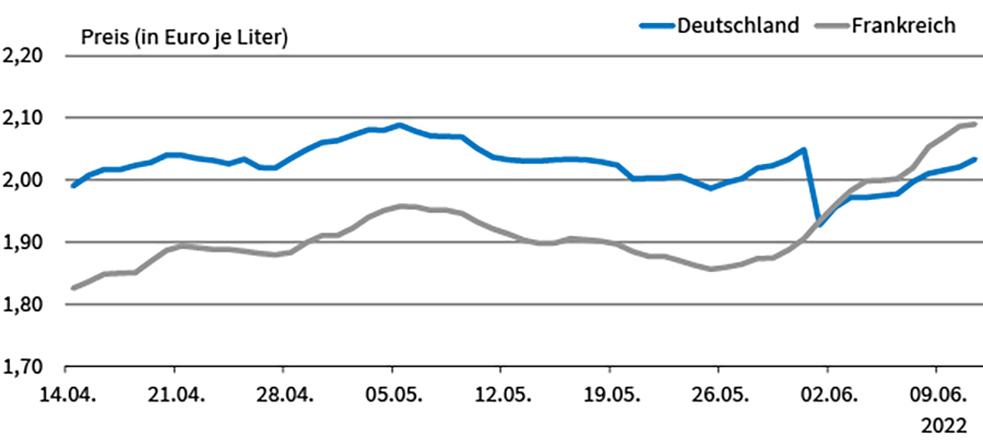
Source: ifo Institute (2022). | Germany (blue), France (grey).
2.3 Germany world leader in electricity prices
The green technologies, which are often praised as cheap, economical and efficient, make life in Germany considerably more expensive. The consideration from an economic perspective is simple: if green technologies were cheap, economical and efficient, everyone in the world would use them. That’s not the case.
Germany (and Denmark) has the highest electricity prices for private households in the world at 0.34 euros per kWh. The price increase has been unchecked for almost two decades (see graphic).[19] The green technologies are making everything considerably more expensive in Germany, from private energy consumption to industrial production.
Chart 5. Electricity prices for household customers in Germany (2011 – 2020, in euro cents per kilowatt hour)
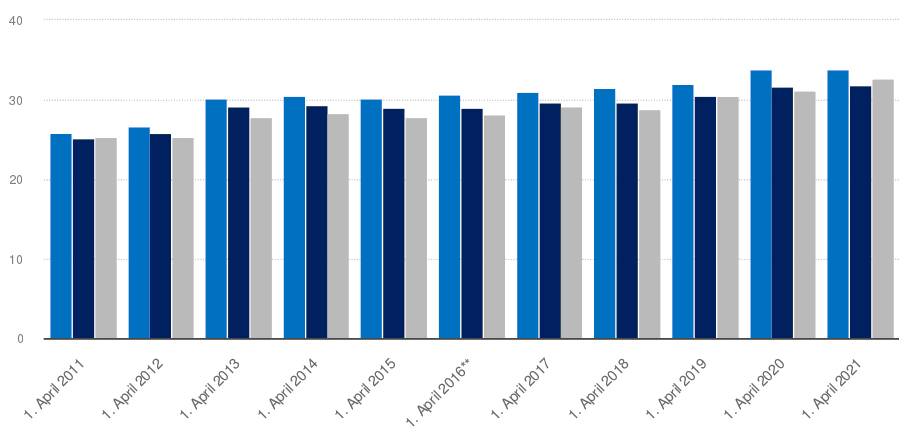
Source: Bundesnetzagentur (2022). | Basic service contract (blue), special contract with the basic supplier (dark blue), different provider than the basic supplier (grey).
France, with its nuclear power, pays almost half at 0.185 euros per kWh. The French will never go the same way as Germany.
2.4 Politically enforced behaviour change
The EU and Germany are therefore forcing their citizens to switch to supposedly climate-friendly technologies. In addition to traditional inflation, green inflation is purposefully used to change the behaviour of individuals. If petrol is artificially made so expensive that it is uneconomical to buy it, electric cars will come by themselves – that’s the idea behind it. Similar to smoking, it will gradually become more expensive and restricted until the desired change in behaviour is achieved in a large part of the population.
Prosperity and opportunities are lost in the process: long-distance travel, individual mobility, use of information technology, cheaper and more reliable transport. All economic and social achievements of the 20th century are reversed “to save the climate” – at least for low and normal earners. But aren’t we all in the same boat when it comes to the “climate protection”?
2.5 All in the same boat?
Is all of Europe going green? Are we all in the same boat? No! Rising prices and impoverishment do not affect everyone at the same time. Society’s better off will continue to enjoy all the benefits of technological advances, increase their wealth and emit CO2 at will. The general public will not be able to afford it. An example from Bavaria:
Katharine Schulze, member of the Bavarian state parliament, Greens parliamentary group, can still jet off to San Francisco for an ice cream.[20]
The cups and spoons are made of plastic, and the flight from Munich to Los Angeles and back emits almost 7 million grams of carbon dioxide. To emit seven million grams of CO2, you would have to travel almost 55,000 kilometres with a modern petrol engine. You can see that we are not all the same.
There are also many supposed “climate champions” internationally who want to change the behaviour of the broad masses but not their own. For example, prince Charles of the UK, who flies inland several times a month and at the same time advocates climate protection.[21]
3. Bavaria and green inflation
3.1 Bavaria: neither competent nor powerless
The causes of inflation and green inflation are beyond the jurisdiction of the Bavaria. The ECB should, at least in theory, act independently and fulfil its mandate of ensuring price stability.
Driven by policy intervention and regulation, green inflation is largely driven by EU and federal policies. However, Bavaria has a larger gross domestic product than most EU countries and thus Bavaria would also have a good political weight to influence the EU and federal level.
Within its own framework, Bavaria can counteract the evil of green inflation somewhat through clever budgeting of its own. While the amounts are small compared to the EU level and ECB debt programs, if “exemplary” is so important in climate policy, then one could also argue that “exemplary” is just as important in fiscal policy. Bavaria should therefore set a good example and clearly reject green spending, especially debt-financed green spending.
3.2 Current financial situation of Bavaria
Bavaria benefited from strong growth in previous legislative periods. 2019 was the most profitable year to date. However, in 2020, under Prime Minister Dr. Markus Söder, Bavaria bid farewell to the goal of completely repaying the state’s debts by 2030.
Chart 6. Brief overview of the Bavarian state budget (2018 – 2022, in billion euros)
| Year | Tax revenue | Administrative revenue | Transfers from the federal level | Total revenue | Government expenditure | Deficit |
| 2018 | 48.9 | 3.1 | 6.7 | 58.7 | 61.7 | -3.1 |
| 2019 | 51.9 | 3.3 | 6.8 | 62.0 | 65.4 | -3.2 |
| 2020 | 47.2 | 3.0 | 7 | 57.2 | 69.2 | -12 |
| 2021 | 45.0 | 3.2 | 8 | 56.2 | 71.4 | -15.3 |
| 2022 | 50.2 | 3.2 | 7.9 | 61.3 | 70.9 | -9.6 |
Source: AfD Parliamentary Group in the Bavarian State Parliament (2022).
As can be seen in the chart above, the financial situation of Bavaria has deteriorated significantly since 2020.[22] The corona restrictions have increased expenditure while income has fallen. The deficit, which was offset in previous years by additional tax revenue or withdrawals from reserves, is now being financed by new debt.
3.3 Unnecessary new borrowing
The corona restrictions allowed the declaration of a disaster. This in turn enabled massive new borrowing in Bavaria (i.e., bypassing the debt brake).
The Bavarian “Corona Pandemic Special Fund” contained 20 billion euros intended exclusively for combating the corona “pandemic”. However, almost 2 billion euros of them were planned for completely different purposes, such as climate protection, high-tech agenda, etc.
Thus, debt-generated demand meets rigid supply as the global market is paralyzed by supply chain issues. Some of the new debt will also be misappropriated to advance the green agenda in Bavaria.
3.4 Unnecessary climate protection initiatives and Bavarian climate protection law
Bavaria has already spent at least 360 million euros on climate protection since 2008 as part of the “Future Bavaria 2020” program.
The new climate protection law with its extensive goals will devour at least one billion per year in the next few years, which will both fuel demand (and thus inflation) and seep away without effect.
In addition to a few sensible measures, the Bavarian state government plans:
- to expand renewable energies.
- massive power line construction, reforming of the 10-hectare distance rule for wind power, photovoltaics wherever possible.
- Climate-neutral building requirements and climate architecture
- a wood construction offensive by which all state buildings have to build with wood facades.
- smart mobility and e-mobility.
- the expansion of charging stations everywhere and 100 percent green electricity, climate buses.
- and finance modern climate research with billions of euros.
As mentioned above, the law is expected to generate up to 22 billion euros in expenditure by 2040.
4. The better alternative: this is what the AfD demands
The parliamentary group of Alternatives for Germany in the Bavarian state parliament has called for careful budgetary policy from the outset. The AfD was the only one to criticize the cut in debt repayments in 2019 and 2020, and also the only one to concede the 2030 repayment target.
During the corona restrictions we were the only dissenting voice, we were the only voice that wanted to curb debt. The AfD parliamentary group is actively taking action against the misappropriation of the corona loans for climate protection and favourite projects of the Söder government.
Our specific demands were and are:
- No more debt! Minimize new borrowing, do not use credit authorizations for inappropriate purposes.
- Binding and speedy debt settlement! Debt repayments were reduced by 90 percent even before the corona restrictions, but the repayments are particularly necessary in times of rising interest rates.
- Do not create funds to create artificial demand for green technologies. We are consistently cancelling all subsidies for climate protection, PV systems, energetic renovations, electromobility and subsidies for green publicity events such as “climate dialogues” and “climate prizes”.
- Investments in actual future technologies. Promoting research into nuclear power, synthetic fuels and revolutionary medical technologies.
- Sensible environmental protection. Preventing planned obsolescence protects the environment and consumers better than CO2 emissions and electromobility.
5. Ending
5.1 Unreliable technologies in times of crisis
Green technologies have brought us to a dead end during the Ukraine conflict. Previously, they were “only” expensive, now they are dangerous for the security of supply. As of July 2022, the natural gas storage facilities in Germany are only 58 percent full. Germany remains dependent on Russian gas.
Coal and nuclear power plants have been shut down because of green ideology. While the coal-fired power plants are now being ramped up again, politicians continue to block operational nuclear power plants such as Isar 2 in Bavaria.
5.2 Understanding and empathy for the actions of other nations
The green inflation and the attempted rescue of the global climate will impoverish Germany without achieving anything.
The moral arrogance of the EU leadership and the federal government not only leads to self-deception, but actually to more fossil fuels on the world market. After a spectacular oil discovery in the Republic of Guyana, its minister for natural resources, Vickram Bharrat, said the following:
“Regardless of climate change, our government will not let the opportunity for prosperity and prosperity go to waste. Which developed country will do that? Demand for oil will not go on forever. In another 20, maybe 30 years, oil may be out of fashion. We have to make sure we’re getting enough of our resources in this short amount of time. It is only fair that we can develop our country as other countries in the world have done. Our people also have the right to enjoy a better life.”[23]
Green ideology doesn’t work for the rest of the world; material prosperity does.
Notes
[1] EZB (2022). Inflation. URL: https://www.ecb.europa.eu/ecb/educational/hicp/html/index.de.html
[2] Bundesregierung (2022). G7 Klimaklub. URL: https://www.bundesregierung.de/bregde/themen/klimaschutz/g7-klimaclub-2058152
[3] Statista. (2022). EZB M3 Geldmenge. URL: https://de.statista.com/statistik/daten/studie/241829/umfrage/entwicklung-der-geldmenge-m3-in-der-euro-zone/
[4] Bankenverband. (2021). Wachstum. URL: https://bankenverband.de/blog/eurozoneproduktivitatswachstum-schwachelt/
[5] EZB. (2022). PEPP. URL: https://www.ecb.europa.eu/mopo/implement/pepp/html/index.en.html
[6] Umweltbundesamt. (2022). Klimaschutz. URL: https://www.umweltbundesamt.de/daten/umwelt-wirtschaft/ausgaben-fuer-den-umweltschutz#entwicklung-der-umweltschutzausgaben
[7] BP (2022). bp Statistical Review of World Energy. URL: https://www.statista.com/statistics/205966/world-carbon-dioxide-emissions-by-region/
[8] Sinn H.W. (2020). Das Klimaproblem und die deutsche Energiewende. Mises Institut. URL: https://www.youtube.com/watch?v=_jBnhq8qnc4
[9] Eberhart, D. (2022). As Gas Prices Soar, Biden’s Bended-Knee Tour Of OPEC Nations Continues. Forbes. URL: https://www.forbes.com/sites/daneberhart/2022/06/15/as-gas-prices-soar-bidens-bended-knee-tour-of-opec-nations-continues/?sh=21a998aa5bb1
[10] Stern (2022). Angst vor dem Frieren: Öfen und Brennholz knapp. URL: https://www.stern.de/wirtschaft/news/energie-angst-vor-dem-frieren–oefen-und-brennholz-knapp–32502670.html
[11] Bundesregierung (2022).
[12] FDP (2022). Lindner will Transformation von Wirtschaft und Gesellschaft. URL: https://www.fdp.de/lindner-will-transformation-von-wirtschaft-und-gesellschaft
[13] Bundestag (2022). Sondervermögen „Energie und Klima“. URL: https://www.bundestag.de/dokumente/textarchiv/2022/kw19-de-sondervermoegen-energie-klima-891886
[14] Fratzscher M. (2022). Willkommene grüne Inflation. DIW. URL: https://www.diw.de/de/diw_01.c.830761.de/nachrichten/willkommene_gruene_inflation.html
[15] Destatis (2022). Inflationsrate im Mai 2022 bei +7,9 Prozent. URL: https://www.destatis.de/DE/Presse/Pressemitteilungen/2022/06/PD22_245_611.html#:~:text=WIESBADEN%20%E2%80%93%20Die%20Inflationsrate%20in%20Deutschland
[16] Statista (2022). Durchschnittlicher Preis für den Kraftstoff Super E10 in Deutschland vom 7. Januar 2014 bis zum 19. Juli 2022. URL: https://de.statista.com/statistik/daten/studie/224101/umfrage/durchschnittlicher-preis-fuer-e10/#professional
[17] Frohn, P. (2020). AUTOBRANCHE
Warum BMW und Daimler ihre Verbrenner-Produktion verlagern – und welche Risiken das birgt , Handelsblatt. URL: https://www.handelsblatt.com/unternehmen/industrie/autobranche-warum-bmw-und-daimler-ihre-verbrenner-produktion-verlagern-und-welche-risiken-das-birgt/26643870.html
[18] ifo Institut (2022). Ölkonzerne geben Tankrabatt zu 85 bis 100 Prozent weiter. URL: https://www.ifo.de/pressemitteilung/2022-06-14/oelkonzerne-geben-tankrabatt-zu-85-bis-100-prozent-weiter
[19] Bundesnetzagentur (2022). Monitoringbericht 2021. URL: https://de.statista.com/statistik/daten/studie/154908/umfrage/strompreise-fuer-haushaltskunden-seit-2006
[20] Stern (2019). Grünen-Politikerin isst im Urlaub ein Eis mit Plastiklöffel – und im Netz gibt es Aufregung. URL: https://www.stern.de/politik/deutschland/katharina-schulze–gruenen-politikerin-isst-im-urlaub-eis-mit-plastikloeffel—shitstorm-im-netz-8516056.html
[21] Nau (2021). Klimaschützer Prinz Charles: 20 Inland-Flüge in einem Jahr. URL: https://www.nau.ch/people/welt/klimaschutzer-prinz-charles-20-inland-fluge-in-einem-jahr-66212794
[22] Own representation from an internal document of the AfD parliamentary group in the Bavarian state parliament based on the budget statement (actual) and budget plans for the current year (target).
[23] Tagessschau (2021). Guyana träumt vom Öl – und fürchtet es. URL: https://www.tagesschau.de/ausland/amerika/guyana-oelboom-101.html
